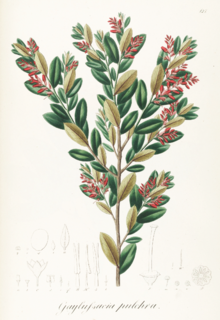| Gaylussacia | |
|---|---|

| |
| Gaylussacia pulchra[1] | |
| Scientific classification | |
| Kingdom: | Plantae |
| Clade: | Tracheophytes |
| Clade: | Angiosperms |
| Clade: | Eudicots |
| Clade: | Asterids |
| Order: | Ericales |
| Family: | Ericaceae |
| Subfamily: | Vaccinioideae |
| Tribe: | Vaccinieae |
| Genus: | Gaylussacia Kunth |
| Type species | |
| Gaylussacia buxifolia Kunth
| |
Gaylussacia is a genus of about fifty species of flowering plants in the family Ericaceae, native to the Americas, where they occur in eastern North America and in South America in the Andes and the mountains of southeastern Brazil (the majority of the known species). Common English names include huckleberry (shared with plants in several other genera) and "dangleberry".
Gaylussacia plants are often a component of an oak-heath forest.[2][3] They are deciduous or evergreen shrubs growing to a height of 0.4–1.8 metres (1 ft 4 in – 5 ft 11 in).
- ^ 1827 illustration from Plantarum Brasiliae icones et descriptiones hactenus ineditae. Vol. 1. Author: Johann Baptist Emanuel Pohl
- ^ The Natural Communities of Virginia Classification of Ecological Community Groups (Version 2.3), Virginia Department of Conservation and Recreation, 2010 Archived January 15, 2009, at the Wayback Machine
- ^ Schafale, M. P. & A. S. Weakley (1990). "Classification of the natural communities of North Carolina" (PDF) (third approximation ed.). North Carolina Natural Heritage Program, North Carolina Division of Parks and Recreation. Archived from the original (PDF) on 2012-04-25.